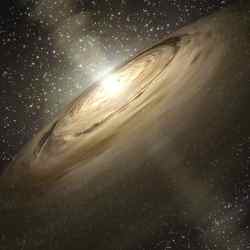
An artist’s impression of the dusty disk orbiting IRS 46. Image credit: NASA/JPL-Caltech Click to enlarge
Astronomers at W. M. Keck Observatory have found ??bf? for the first time ??bf? some of the basic compounds necessary to build organic molecules and one of the bases found in DNA within the inner regions of a planet-forming disk. The object, known as “IRS 46,” is located in the Milky Way galaxy, about 375 light years from Earth, in the constellation Ophiuchus. The results will be published in an upcoming issue of the Astrophysical Journal Letters.
“We see prebiotic organic molecules in comets and the gas giant planets in our own solar system and wonder, where did these chemicals come from?” said Dr. Marc Kassis, support astronomer at the W. M. Keck Observatory. “The Spitzer Space Telescope is letting us study these young stellar objects in new and revealing ways, giving us exciting clues about where life may form in the universe.”
The two organic compounds found — acetylene and hydrogen cyanide — are commonly found in our own solar system, such as the atmospheres of the giant gas planets, the icy surfaces of comets, and the atmosphere of Saturn??bf?s largest moon, Titan. Another carbon-containing species detected, carbon dioxide, is widespread in the atmospheres of Venus, the Earth, and Mars.
“If you add hydrogen cyanide, acetylene and water together in a test tube, and give them an appropriate surface on which to be concentrated and react, you’ll get a slew of organic compounds including amino acids and a DNA purine base called adenine,” said Keck Astronomer Dr. Geoffrey Blake, of the California Institute of Technology in Pasadena and co-author of the paper. “Now, we can detect these same molecules in the planet zone of a star hundreds of light-years away.”
The presence of gas-rich disks around young stars is well known, but little is understood about the chemical structure inside. The discovery of acetylene and hydrogen cyanide in one of these disks will help astronomers better understand these disks, where future solar systems may someday form and possibly result in life.
“Spitzer found something very unique — a young protostar with a dusty disk that, when viewed from Earth, appears tilted on the sky, similar to how some galaxies appear,” Kassis explained. “This viewing angle let the team use Keck-NIRSPEC data to study the inner regions of the disk. The results told the team exactly how the disk was moving and suggest there may be a stellar wind coming from the inner region. Keck also helped measure the high temperatures and the particle concentration in the disk.”
The dust and gas surrounding a young star blocks visible light, but lets longer wavelengths, such as infrared light, pass through. Astronomers can find out what this gas and dust is made of by separating the light into its component wavelengths, or colors.
Since 2003, the NASA Spitzer Space Telescope has allowed astronomers to use this technique to study molecular compounds in protoplanetary disks of young stellar objects. The Spitzer “c2d legacy program” has looked at more than 100 sources in five nearby star-forming regions and only one ??bf? IRS 46 ??bf? showed clear evidence of containing the organic compounds in the warm regions close to the star where terrestrial planets are most likely to form.
“This infant system might look a lot like ours did billions of years ago, before life arose on Earth,” said Fred Lahuis of Leiden Observatory in the Netherlands and the SRON Netherlands Institute for Space Research. Lahuis is the lead author of the paper describing the results.
While the precise events leading up to self-replicating nucleic acids remains unclear, the molecules of acetylene (C2H2) and hydrogen cyanide (HCN) have been shown to produce the base compounds necessary to build RNA and DNA. The team found that the abundance of hydrogen cyanide (HCN) was nearly 10,000 times higher than that found in cold interstellar gas from which stars and planets are born.
Models of early solar-system chemistry have historically centered on data from our own primitive solar system, but now discoveries of protoplanetary disks have opened the field to solar systems other than our own. Theoretical models have suggested that large quantities of complex organic molecules would be present in the inner-most regions of these disks, but until now, no observational tests have been possible.
To help determine where, exactly, the organic-rich gas resides in IRS 46, the team also used submillimeter data from the James Clerk Maxwell Telescope on Mauna Kea. The faint signals observed again suggest that the material originates from the inner disk, perhaps no more 10 astronomical units from the parent star, similar in distance to where Saturn orbits the Sun in our own solar system. However, much additional work remains to be done to know this for certain.
“The gases are very warm, close to or somewhat above the boiling point of water on Earth,” said Dr. Adwin Boogert, also of Caltech. “These high temperatures helped to pinpoint the location of the gases in the disk.”
The Keck-NIRSPEC results point to the presence of a stellar wind emerging from the inner region of the disk orbiting IRS 46. The wind may eventually blow away the dusty debris in the disk, perhaps revealing the presence of rocky, Earth-like planets in several million years.
The Jet Propulsion Laboratory manages the Spitzer Space Telescope mission for NASA’s Science Mission Directorate, Washington. Science operations are conducted at the Spitzer Science Center at Caltech. JPL is a division of Caltech.
The W. M. Keck Observatory is managed by the California Association for Research in Astronomy, a non-profit 501 (c) (3) corporation. The Keck I and Keck II 10-meter telescopes probe the faintest objects in the optical and infrared Universe.
Original Source: W. M. Keck Observatory

Hello! human growth hormones